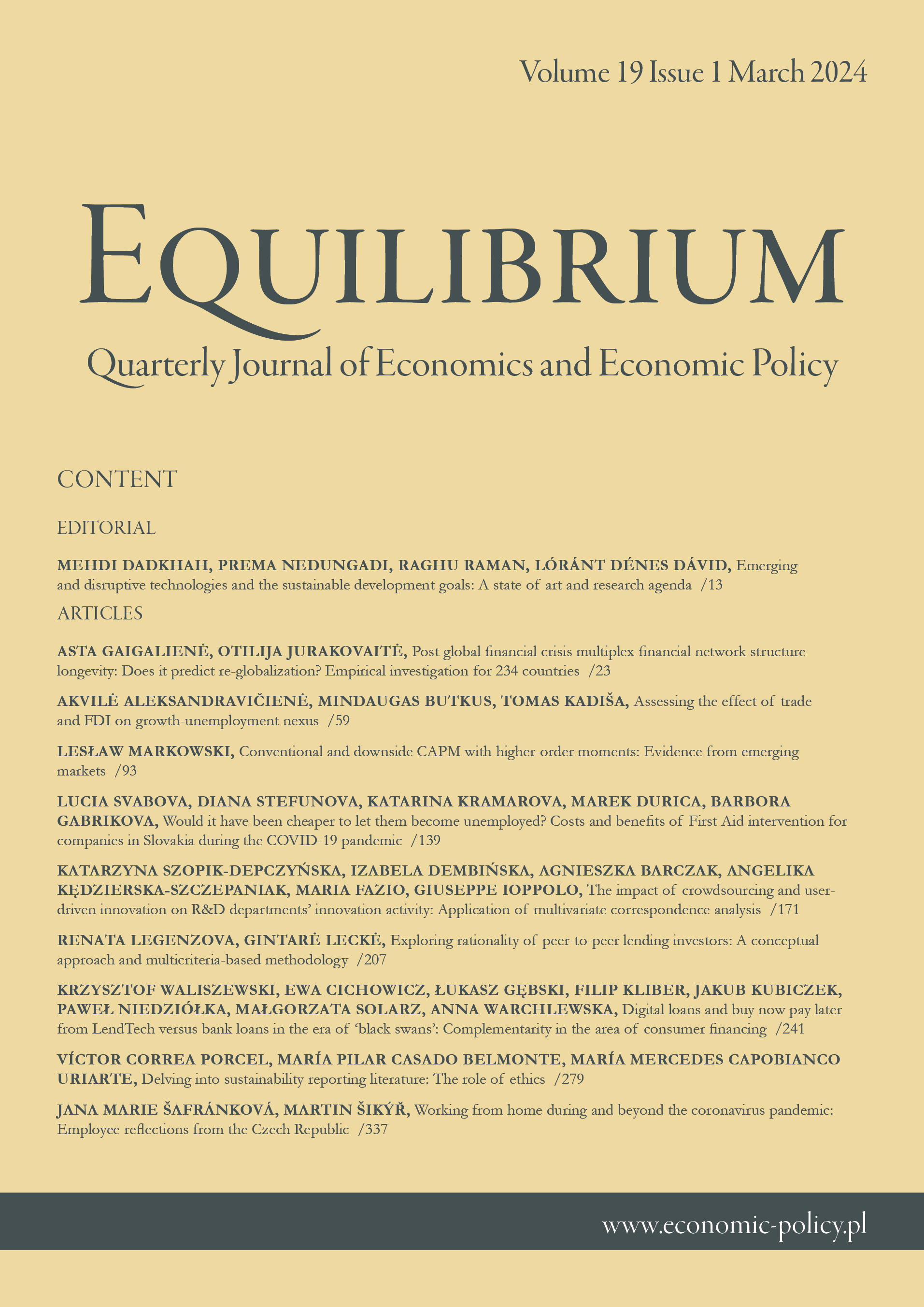Contribution of various income sources to interregional inequality of the per capita income in the Russian Federation
IF 5
Q1 ECONOMICS
Equilibrium-Quarterly Journal of Economics and Economic Policy
Pub Date : 2017-09-30
DOI:10.24136/EQ.V12I3.21
引用次数: 8
Abstract
Research background: The reduction lately observed in interregional differences in the per capita income in Russia requires some clarification of the reasons. One possible way to do this could be decomposition of interregional inequality in personal incomes by income sources, i.e.: wages and salaries, property incomes, social transfers, entrepreneurship incomes and revenues from informal activities. Purpose of the article: The objective of this research is identification of the character, direction and degree of influence of various income sources on interregional inequality and convergence of Russian regions by their per capita income in 2001–2014. Methods: We brought personal incomes in the regions to a comparable level using the relative cost of fixed consumer basket. Then we applied the population-weighted Gini coefficient, coefficient of variation, and the Theil index to measure the interregional inequality in personal incomes in dynamics. Further usage of various techniques of inequality decomposition allowed us to evaluate contribution of different types of income to the Russian regions’ convergence across time. Findings & value added: Various types of income demonstrated different paths of interregional inequality, changes in interaction and in the shares of total income, which altogether influenced spatial inequality. Wages and salaries showed the largest and growing impact on inequality. The contribution of informal incomes to the overall inequality was the second largest, but diminishing and negatively interacting with other unevenly distributed types of income; thereby they provided more than half of the total interregional convergence. Entrepreneurship incomes revealed slightly decreasing influence on inequality, which was mainly neutralized by their reduction in the share of total income. Social transfers demonstrated the largest smoothing effect, however, their contribution to convergence was exhausted. Property incomes evidenced the greatest enhancing impact on inequality especially in the period of recovery. Additionally, informal incomes played the role of substitutes for formal incomes providing self-replicating mechanisms for reducing inequality in Russia.各种收入来源对俄罗斯联邦区域间人均收入不平等的贡献
研究背景:最近观察到的俄罗斯人均收入地区间差异的减少需要澄清一些原因。实现这一目标的一种可能方法是按收入来源分解个人收入的区域间不平等,即:工资和薪金、财产收入、社会转移、创业收入和非正规活动收入。本文的目的:本研究的目的是通过2001-2004年俄罗斯地区的人均收入来确定各种收入来源对地区间不平等和趋同的影响的特征、方向和程度。方法:我们使用固定消费者篮子的相对成本将这些地区的个人收入提高到可比水平。然后,我们应用人口加权基尼系数、变异系数和泰尔指数来动态衡量地区间个人收入的不平等。进一步使用各种不平等分解技术,使我们能够评估不同类型的收入对俄罗斯地区随时间趋同的贡献。研究结果和附加值:不同类型的收入显示出不同的区域间不平等路径、相互作用和总收入份额的变化,这些都影响了空间不平等。工资和薪金对不平等的影响最大,而且越来越大。非正规收入对总体不平等的贡献位居第二,但正在减少,并与其他分配不均的收入类型产生负面影响;因此,它们提供了区域间趋同总量的一半以上。创业收入对不平等的影响略有下降,这主要是由于创业收入在总收入中所占份额的减少而抵消的。社会转移显示出最大的平滑效应,然而,它们对趋同的贡献已经耗尽。房地产收入对不平等的影响最大,尤其是在复苏时期。此外,非正规收入发挥了正规收入的替代品的作用,为减少俄罗斯的不平等现象提供了自我复制的机制。
本文章由计算机程序翻译,如有差异,请以英文原文为准。
求助全文
约1分钟内获得全文
求助全文
来源期刊
CiteScore
9.20
自引率
3.50%
发文量
28
审稿时长
36 weeks
期刊介绍:
Equilibrium. Quarterly Journal of Economics and Economic Policy is a scientific journal dedicated to economics, which is the result of close cooperation between the Instytut Badań Gospodarczych/Institute of Economic Research (Poland) and Polish Economic Society and leading European universities. The journal constitutes a platform for exchange of views of the scientific community, as well as reflects the current status and trends of world science and economy.
The journal especially welcome empirical articles making use of quantitative methods in: Macroeconomics and Monetary Economics, International Economics, Financial Economics and Banking, Public Economics, Business Economics, Labor and Demographic Economics, Economic Development, and Technological Change, and Growth.
Current most preferable topics and special issues:
The economics of artificial intelligence: business potentials and risks;
Digitalization and entrepreneurship in economics;
Sustainable socio-economic development, environmental and ecological economics;
Transition in the energy market (improving energy efficiency, alternative energy sources, renewable energy, energy security).

 求助内容:
求助内容: 应助结果提醒方式:
应助结果提醒方式:


